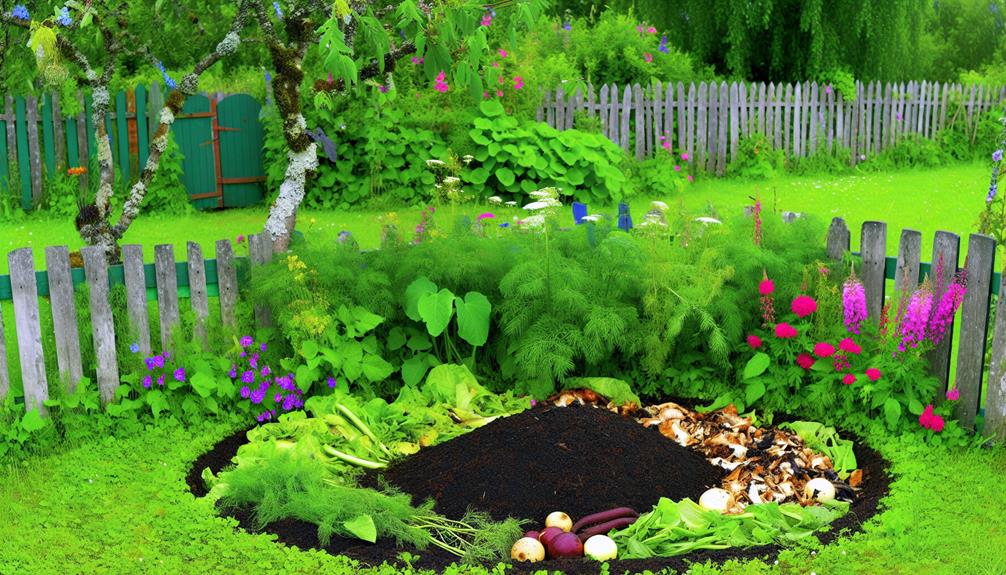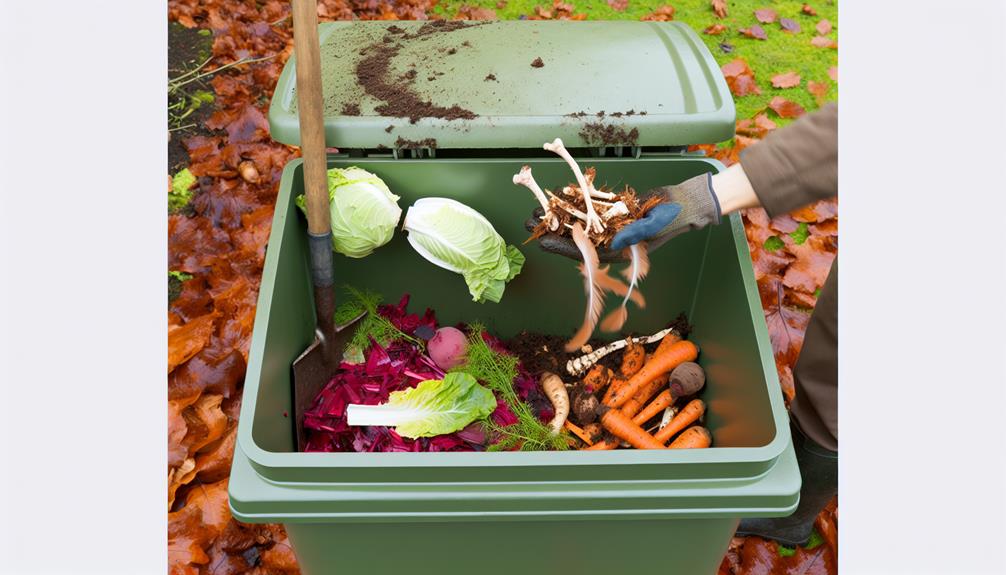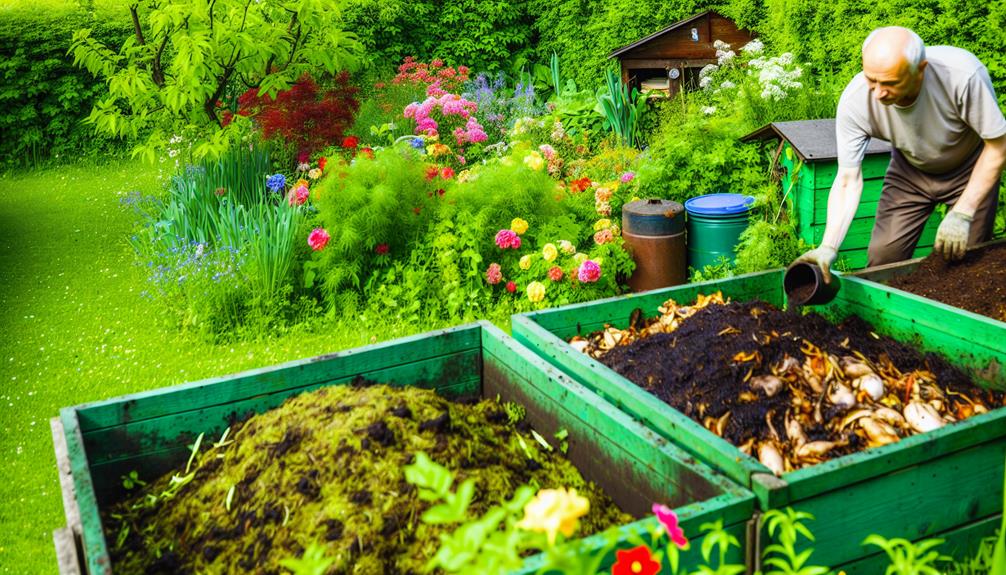

Yes, you can compost poultry. First, chop the poultry waste into smaller pieces and store it in a freezer until you’re ready to compost. Thaw completely before use. Balance the compost with carbon-rich materials like wood chips or straw to maintain a 30:1 carbon-to-nitrogen ratio.
Proper layering and moisture control are vital—aim for a mix that feels like a wrung-out sponge. Regularly turning the compost helps with aeration and speeds up decomposition. Monitoring the compost temperature, ideally between 130°F and 160°F, guarantees it breaks down effectively. Explore safe handling practices and common mistakes to avoid for more insights.
Composting poultry offers numerous benefits, including reducing waste and creating nutrient-rich soil. By composting, you can greatly cut down on the amount of waste that ends up in landfills. This not only helps the environment but also makes your household more sustainable. Waste reduction is essential for decreasing your carbon footprint and promoting a greener community.
When you compost poultry, you’re also contributing to soil enrichment. The compost created from poultry waste is rich in essential nutrients like nitrogen, phosphorus, and potassium. These nutrients are important for healthy plant growth. By adding this compost to your garden, you’ll improve soil structure, enhance water retention, and boost the overall fertility of the soil. This means your plants will grow stronger and healthier, creating a more vibrant and productive garden.
To get started, make sure you have a proper compost bin and understand the basics of composting. Layer your poultry waste with other compostable materials like leaves and vegetable scraps. Regularly turn the compost to ensure proper aeration, and monitor moisture levels. By following these steps, you’ll maximize the benefits of composting poultry, achieving both waste reduction and soil enrichment.
When deciding what to compost, it’s important to know which types of poultry waste are most effective for creating nutrient-rich compost. Incorporating poultry into your composting routine not only promotes waste reduction but also supports sustainable practices.
Here are four types of poultry waste you can use:
Also Read: Can You Compost Cat Feces?
To prepare poultry waste for composting, start by gathering your materials and making sure they’re free of any contaminants like plastic or chemicals. This step is essential to maintaining a healthy compost environment. Use cleaning tools, such as a dedicated knife and cutting board, to process the poultry. These tools should be sanitized before and after use to prevent any unwanted bacteria from entering your compost.

Next, consider the storage methods for your poultry waste. If you’re not planning to compost immediately, store the waste in a sealed container in the freezer. This prevents odors and deters pests from getting into your compost materials. When you’re ready to compost, thaw the poultry waste completely. Partial thawing can hinder the composting process and slow down decomposition.
Chop the poultry waste into smaller pieces. Smaller pieces break down faster and integrate more efficiently with other compost materials. Always wear gloves to protect your hands during this process.
To balance carbon and nitrogen in your poultry compost, you need to understand the sources of each. Use carbon-rich materials like straw, wood chips, or leaves.
For nitrogen, add fresh poultry manure and food scraps to create a balanced and efficient composting process.
Balancing carbon and nitrogen in your compost pile starts with selecting the right carbon-rich materials. These materials are essential for providing the necessary structure and aeration, ensuring your pile doesn’t become a slimy mess.
Here are some excellent carbon sources you should consider:
These carbon-rich materials are key to maintaining a healthy compost pile. They prevent compaction, allowing air to flow and microorganisms to thrive. Remember to layer these materials with your nitrogen-rich items to keep everything balanced.
Now, you’re well on your way to successful composting!
When you’re adding nitrogen-rich materials to your compost pile, think of items like fresh grass clippings and kitchen scraps. These materials are essential for maintaining the nitrogen cycle within your compost. They help break down the carbon-rich materials, balancing the carbon-to-nitrogen ratio, which is vital for efficient decomposition.
Incorporating green manure, such as clover or alfalfa, can greatly boost the nitrogen content of your compost. Green manure not only provides nitrogen but also improves soil structure and fertility. To maintain an effective compost, aim for a ratio of approximately 30 parts carbon to 1 part nitrogen. This balance ensures that microorganisms thrive, speeding up the composting process.
Remember to mix nitrogen-rich materials thoroughly with carbon-rich ones. This prevents the pile from becoming too wet or too dry, which can slow down decomposition. If your pile starts to emit a strong odor, it’s a sign that there’s too much nitrogen. In that case, add more carbon-rich materials like straw or dry leaves.
Also Read: Can You Compost Rust?
To avoid odors in your compost, start by using proper layering techniques to balance the materials.
Make sure to manage moisture levels carefully, as too much or too little water can cause unpleasant smells.
Additionally, incorporating carbon sources like straw or wood chips helps to neutralize any odors.
By alternating layers of poultry waste with carbon-rich materials like straw or wood chips, you can prevent unpleasant odors in your compost. Proper layering techniques are essential to maintain a healthy and odor-free compost pile. Here’s a straightforward guide to help you create effective compost layers:
Maintaining ideal moisture levels in your compost is essential for preventing unpleasant odors and ensuring efficient decomposition. Your compost should feel like a wrung-out sponge—moist but not waterlogged.
Too much moisture can cause anaerobic conditions, leading to foul smells. To manage this, start by ensuring you’ve got a good drainage system in place. This can be as simple as drilling holes in your compost bin or elevating it to allow excess water to escape.
Next, focus on water absorption. Adding materials like straw, shredded newspaper, or sawdust can help soak up excess moisture. When you add poultry waste, which is often high in water content, balance it out with these dry, carbon-rich materials.
Don’t forget to turn your compost regularly. Aeration helps water evaporate and keeps bacteria working efficiently.
If you notice your compost is too dry, lightly sprinkle it with water. Be cautious not to overdo it. A little moisture goes a long way.
Balancing your compost with carbon sources like straw or shredded newspaper not only helps manage moisture but also plays a key role in preventing foul odors. When you add poultry waste to your compost, it’s important to incorporate enough carbon-rich materials.
This combination supports effective carbon sequestration and enhances microbial activity, which are essential for breaking down organic matter efficiently.
To make sure your compost remains odor-free and healthy, follow these tips:
To guarantee safe composting, always handle poultry scraps with care to prevent contamination and promote a healthy composting process. The key to cross contamination prevention is to keep your workspace clean and separate raw poultry from other compost materials.
Always wash your hands, cutting boards, and utensils thoroughly after meat handling. This simple step helps maintain a hygienic environment and guarantees your compost remains uncontaminated.
When adding poultry scraps to your compost, make sure they’re chopped into small pieces. Smaller pieces decompose faster and reduce the risk of attracting pests. Use a dedicated compost bin for any meat products to avoid mixing them with other food scraps prematurely.
This separation helps manage odors and keeps your compost pile balanced.
Cover poultry scraps with a generous layer of carbon-rich materials, like leaves or straw, to help with odor control and decomposition. Regularly turning your compost pile will also help aerate it and promote faster breakdown of materials.
Also Read: Can You Compost Cardboard Tubes?
Using compost accelerators can greatly speed up the decomposition process of your poultry scraps. You’ll find different types available, each with specific application methods.

Let’s explore the benefits and drawbacks of these accelerators to help you make an informed choice.
Compost accelerators, including natural additives like manure and commercial products, can greatly expedite the decomposition process in your poultry compost. These accelerators break down organic matter faster, making your compost ready for use in a shorter time.
Here are four types of accelerators you can consider:
Applying compost accelerators effectively involves understanding the right quantities and methods to integrate them into your poultry compost pile. Start by choosing the right compost accelerator; it could be a commercial product or natural additives like manure or green plant material.
First, layer your poultry waste with other organic materials like leaves, straw, or kitchen scraps. This aids in balancing nitrogen and carbon, important for the composting process. Sprinkle the accelerator evenly over each layer. If you’re using a commercial product, follow the dosage instructions on the package.
Next, water the pile lightly to maintain moisture, but don’t let it get soggy. Moisture helps the accelerators activate, speeding up decomposition. Regularly turn the compost pile to aerate it. This ensures that oxygen penetrates the layers, further enhancing the composting process.
Monitor the temperature of your pile. Compost accelerators often raise the internal temperature, which is a sign of active decomposition. If the pile cools down too much, consider adding more accelerator and turning it again.
Using proper application methods will help you achieve rich, usable compost from your poultry waste efficiently, fostering a sense of accomplishment and sustainability within your community.
While proper application methods are essential, it’s also important to weigh the benefits and drawbacks of using compost accelerators in your poultry compost pile. Compost accelerators can enhance the decomposition process and improve nutrient retention, but they come with their own set of considerations.
Benefits:
Drawbacks:
Understanding these factors can help you make informed decisions, ensuring your poultry composting is effective and environmentally responsible.
Monitoring the temperature carefully is crucial for successful poultry composting. You need to keep an eye on the temperature to guarantee ideal microbial activity.
These microorganisms are the engines driving the composting process, and they thrive in a specific temperature range. Ideally, the compost pile should maintain a temperature between 130°F and 160°F. This range helps break down the poultry waste efficiently and eliminates harmful pathogens.
Temperature fluctuations can disrupt microbial activity, leading to slower decomposition and potential odor issues. To avoid this, regularly check the temperature using a compost thermometer. Insert the thermometer into different sections of the pile to get an accurate reading. If the temperature drops significantly, it may indicate that the microbes need more oxygen. Aerate the pile by turning it to introduce fresh air.
Conversely, if the temperature exceeds 160°F, it can kill beneficial microbes and halt the composting process. In this case, you should turn the pile to release some heat and restore balance.
Monitoring and maintaining the right temperature ensures your poultry composting efforts are successful and efficient. Remember, consistency is key to fostering a healthy compost environment.
One common mistake in poultry composting is failing to maintain the proper moisture level in the compost pile. If your pile is too dry, decomposition slows down, while excessive moisture can lead to foul odors and attract pests. Aim for a damp, not soggy, consistency, similar to a wrung-out sponge.
Improper storage of poultry waste is another frequent error. Storing it in open containers or leaving it exposed invites pests like rodents and insects. Always use a sealed bin or a covered compost pile to keep the unwanted critters at bay.
Here’s a quick list of mistakes to watch out for:
Incorporate poultry compost into your garden soil to boost nutrient levels and improve plant health. Poultry compost is rich in nitrogen, phosphorus, and potassium, which are essential nutrients for plant growth.
To start, mix the compost thoroughly with your garden soil. Aim for a ratio of one part compost to three parts soil. This blend enhances soil fertility, ensuring your plants get the nutrients they need.
Additionally, poultry compost aids in pest control. The organic matter attracts beneficial insects and microorganisms that help keep harmful pests at bay. When you spread a thin layer of compost around the base of your plants, it acts as a natural pest deterrent, creating a healthier environment for your garden.
Make sure to use well-aged compost. Fresh poultry compost can be too strong and might harm your plants. Let it decompose for at least six months before application. This aging process reduces the risk of burning plants and balances pH levels.
Incorporating poultry compost into your gardening routine is a sustainable practice that promotes stronger, healthier plants. By enhancing soil fertility and aiding in pest control, you’re setting your garden up for success.
Start using poultry compost today and see the difference it makes!
You can compost poultry bones by grinding bones first for faster decomposition. Alternatively, consider bone alternatives like plant-based scraps. Join the eco-friendly community in reducing waste and enriching your compost with nutrient-rich materials.
To decompose poultry in compost, you’ll need to maintain proper moisture levels and carbon balance. It usually takes about six months. By doing this, you’re contributing to a healthier, more sustainable community.
It’s safe to compost poultry during hot weather if you manage heat properly and control odors. By ensuring your compost pile maintains the right temperature, you’ll create a welcoming environment for effective and safe composting.
Yes, composting poultry can attract pests or wildlife. You need to practice odor control and pest prevention by burying the poultry deep in the compost pile and covering it with carbon-rich materials like leaves or straw.
To safeguard against pathogens when composting poultry, you need to guarantee proper temperature control and regular compost aeration. Maintain temperatures above 131°F and turn the pile frequently. You’ll keep your compost safe and your community healthy.
Composting poultry is a practical way to enrich your garden soil. Make sure you balance carbon and nitrogen, and prepare poultry properly to avoid odors.
Use compost accelerators and monitor the temperature to speed up decomposition. Avoid common mistakes like overloading the compost with poultry. With attention to detail, you’ll create nutrient-rich compost that benefits your plants.
Follow these guidelines, and your garden will thrive with the added boost from poultry compost.
